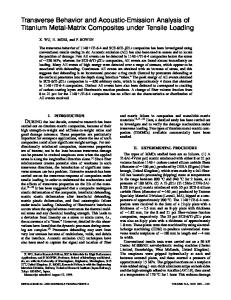Effects of Microstructure on Transverse Tensile Strengths of Ceramic Composites Studied by the FFT-Based Method
- PDF / 4,934,262 Bytes
- 18 Pages / 595.276 x 790.866 pts Page_size
- 30 Downloads / 388 Views
ORIGINAL PAPER
Effects of Microstructure on Transverse Tensile Strengths of Ceramic Composites Studied by the FFT-Based Method Meng Wang 1 Received: 28 August 2020 / Accepted: 3 November 2020 # Springer Nature B.V. 2020
Abstract To evaluate the effects of microstructure characteristics on the properties of SiC/SiC composites (Silicon Carbide Fiber/Silicon Carbide Matrix), models with different fiber and void shapes are analyzed with the FFT-based method. Especially for the voids, a newly developed method is presented for the random void generation. The FFT-based method is validated through comparing the predicted results with those from the FEM method and published literature. For the circular shaped fiber models, it is found that the damage initiates in the matrix around the fibers and with the increase of loading, the damages are joint. After considering the voids, the failure strength decreases and the random voids contribute to the largest decrease degree. The gear shaped fiber models have larger equivalent transverse modulus and strength compared with the circular shaped fiber models. The predicted failure strength also decreases due to the voids. However, the failure strength is less sensitive to the void shape than that of the circular shaped fiber model, as the interphase damage induced by the gear teeth plays an important role for the damage initiation. Keywords FFT-based method . Fiber shape . Void shape . Ceramic composite . Transverse tensile strength
1 Introduction Composites are widely used in the aerospace engineering, automobile engineering, civil engineering and so on. Especially for the ceramic composites, it is widely used in the extreme circumstances. Thus, the property prediction now is the hotpot for the composite research especially in the transverse direction, because the transverse properties are highly dependent on the microstructures. Computational mechanics has been widely for the prediction of composite properties. The finite element method (FEM) as a numerical method was adopted in many studies for the transverse property prediction of polymer and ceramic composites. For the polymer composites, effects of different microstructure characteristics on the elastic and strength properties have been revealed including the fiber distribution, fiber shape, void distribution, void shape and so on. The effects of fiber distribution patterns
* Meng Wang [email protected] 1
Jiangsu Key Laboratory of Environmental Impact and Structural Safety in Engineering, School of Mechanics & Civil Engineering, China University of Mining and Technology, Xuzhou 221116, China
on the elastic and inelastic properties of polymer composites have been revealed with the FEM method [1–4]. It has been found that the results predicted from the fiber random distribution model are more close to the experimental results. For virtual material design purpose, the computational micromechanics method has been adopted to reveal the effects of fiber shape on the transverse properties of polymer composites under static and dy
Data Loading...











